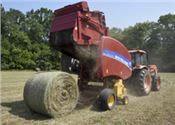|
Pests Weaken Hay Production

Joe Stewart operates a baler in an Oktibbeha County, Mississippi, hayfield.
Photo by MSU Extension Service/Kevin Hudson
STARKVILLE, MISS.
Forage growers in Mississippi are trying to keep insects from making meals out of their hayfields and compromising their stockpiles of winter feed.
Mississippi State University Extension Service forage specialist Rocky Lemus estimates that the state has 650,000 acres in hay production, while the U.S. Department of Agriculture National Agricultural Statistics Service projects a 590,000-acre harvest, excluding alfalfa. The USDA estimate would be a 20,000-acre decrease from the 610,000 acres harvested last year.
Lemus said yields are also low this year. Producers are cutting a little more than 1 ton per acre, compared with the norm of 2 to 3 tons.
“Excessive rain in late June and early July delayed second harvest, and third cuts of bermudagrass hay have been affected by high infestations of fall armyworms and bermudagrass stem maggots,” he said. “The major effect of sugarcane aphids is seen in fields that producers established in sorghum-sudangrass or forage sorghums for summer grazing or hay production. Impact in Pearl millet has been less since it tends to have a better resistance to aphids.”
Fall armyworms, found annually in hay fields, have their highest populations at this time of year. But producers have seen higher numbers of them in the last five years.
“We’ve certainly had our share of armyworms, more so than last year in this part of the state,” said Brett Rushing, Extension forage agronomist at the MSU Coastal Plain Branch Experiment Station in Newton. “Growers in central and south Mississippi are spraying a lot for armyworms and stem maggots. They’re a threat you have to be willing to expect year in and year out, and what we can use to control them is limited – particularly in hayfields with Johnsongrass where aphids are a threat – because most products have grazing or haying restrictions that affect how we use the forages.”
Extension entomologist Blake Layton said undetected armyworm infestations can lead to quick, widespread forage loss.
“A hayfield that looks beautiful and ready to cut on a Thursday morning may be nothing but stems by Saturday,” Layton said. “Fall armyworms are easily controlled with timely insecticide sprays, but you have to detect infestations early and have your spray equipment ready to go. Treatment is recommended when counts exceed three caterpillars per square foot.”
As the fall season approaches, Lemus recommended that producers consider purchasing cool-season forage seeds soon.
“When producers start to look for annual ryegrass seed, they might see an increase in the cost per pound of seed,” he said. “It is advisable to start planning now and secure some seed before seed demand might create an increase in prices.”
The Coastal Plain Branch Experiment Station, located at 51 Coastal Plain Road in Newton, will be the site of an Extension fall forage field day Sept. 27 for forage and livestock producers. Topics will include grazing management, forage production, drought insurance, economics and variety selection.
The free program runs from 3-7 p.m. and includes a catered dinner. The preregistration deadline is Sept. 21. To preregister, contact Jenna Mosley at 601-683-2084 or jlt205@msstate.edu. ∆
|
|